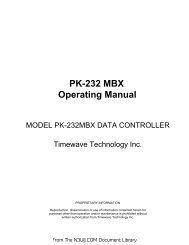TH-D72A/E - N3UJJ
TH-D72A/E - N3UJJ
TH-D72A/E - N3UJJ
Create successful ePaper yourself
Turn your PDF publications into a flip-book with our unique Google optimized e-Paper software.
2 HOW YOU ENJOY APRS WI<strong>TH</strong> <strong>TH</strong>-<strong>D72A</strong>/E (WRITTEN BY BOB BRUNINGA, WB4APR)Facebook on APRSPurely as an aside, you can think back to the Kenwood VC-H1 handheld SSTVdevice as an attempt (before its time) to add the visual aspect of socialnetworking to ham radio and APRS. This was a fantastic idea. And it was fullyintegrated into all Kenwood APRS radios at the time, adding real-time video toAPRS digital and texting connectivity. You could think of the combination asreal-time “Facebook” on APRS. Unfortunately it was ahead of its time and theVC-H1 handheld is no longer in production, but thousands of hams have themand still use them. These SSTV handhelds along with readily available freeSSTV software make a great visual adjunct to APRS. This was in the early2000 time frame before anyone had camera phones. Think of the potential.Snap an image, and send it into APRS where it was picked up by a web sitethat cataloged it by position, originator and a text description for viewing byanyone. This can be a tremendous asset for ham radio public service. Thereare a few such active links from APRS and SSTV to the web called theAutomatic Picture Relay Network, or APRN.Refer to: http://aprs.org/aprn.htmlAPRS Voice AlertThree things dramatically brought back human connectivity to APRS. The first factor was Voice Alert.The second was the addition of a Frequency field in all APRS position packets. And the third was theemergence of VOIP Internet/ham radio linked voice. Voice alert is like a 3 rd simultaneous radiochannel on the Kenwood APRS transceivers. It acts like an intercom channel for all APRS operatorsto be able to quickly raise another nearby APRS voice alert station by a simple direct voice call. Itrequired no new hardware or software. It simply consists of setting CTCSS 100 Hz on the APRSdata channel and keeping the speaker volume up. This way, all packet noise was completely muted,but the operator could still be called at any time with a CTCSS 100 Hz voice call. A secondarybenefit to this technique was a free proximity detector. If any other Voice Alert station got withinsimplex range (maybe 5 miles or less) his periodic packets would give an audible alert. These newfeatures of APRS Voice Alert as indicated in the APRS Mobile Information Exchange drawing abovefinally made it easy to keep the eyes on the road, but never miss the opportunity for human contactwith a fellow APRS operator on the open road. Voice Alert is now on the Function Menu in the<strong>TH</strong>-<strong>D72A</strong>/E.Frequency Data FieldAt the nearly same time (2004), the Frequency field was added to the position packet specification.This standardized the inclusion of a voice operating frequency in the APRS system. APRS wasnever intended as an end-in-itself, but as a tool to be applied to all aspects of ham radio and humancontact. Knowing other station’s voice contact frequency in many cases is even more important forestablishing communications than knowing position. Now every ham could announce his monitoringfrequency in his APRS packet and could call others on their indicated frequency. Kenwood was thefirst to leverage the value of this capability by releasing the TM-D710A/E in 2007. This radio (as wellas the new <strong>TH</strong>-<strong>D72A</strong>/E) not only automatically includes your voice band frequency in every positionpacket but can also then tune to someone else’s frequency by simply selecting “Tune” as shownbelow.8 CONTENTS <strong>TH</strong>-<strong>D72A</strong>/EFrom The <strong>N3UJJ</strong>.COM Document Library
















